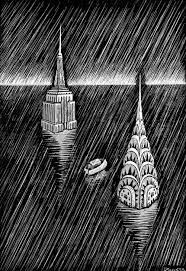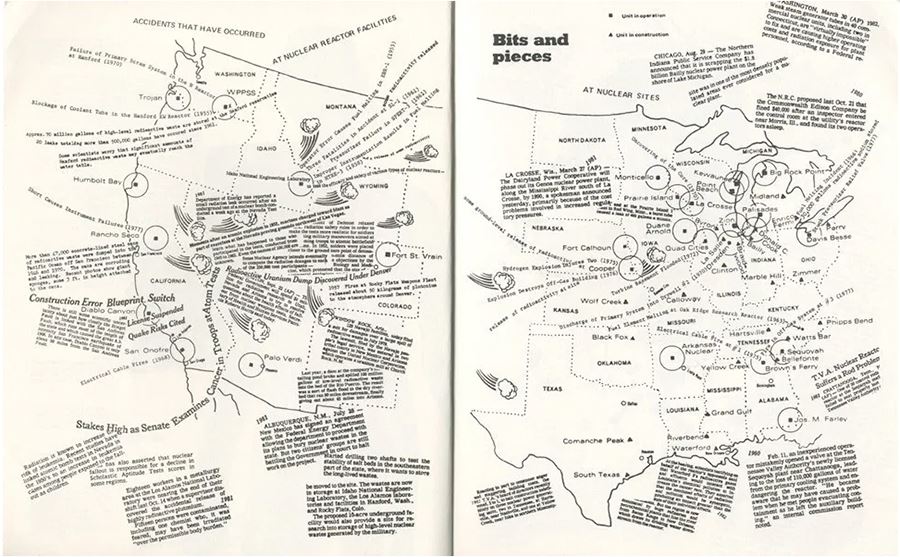In 1912, after surviving the sinking of the Titanic, Gertrude Jean Hippach was quoted as saying, “Yes, it was terrible, but it still seems like a dream to me.”
For artists, who traffic in dreams and the collective imagination, disaster rarely comes as a surprise, simply because suffering is ever present, even if occurring in some otherplace or othertime. This is not to say that this is a comfortable or even conscious process, especially when the othertime is the future. In my own work I have often had the experience of being drawn to subject matter that I couldn’t explain, which later emerged in the world. My project Titanic, for example, an altered edition of the Wall Street Journal, which explored the relationship between disaster and denial, was completed in 2004, just three years before the collapse of the sub-prime market, another ship considered “too big to sink.”
Often the role of artists is to “see” what others refuse to. In Eric Drooker’s 1992 novel-in-pictures Flood, the artist envisioned—through graphic black and white images—a Manhattan of the future sunk by deluge-like rains. The power of Drooker’s work lay not in his ability to predict rising sea levels—that work had already been done—but to depict it in a way that IPCC reports couldn’t.

Flood, Eric Drooker, image courtesy of the artist
For many artists, seeing means looking to the past and wielding knowledge / information as a weapon. In Sharon Gilbert’s Nuclear Atlas, the pages are dizzying, a visual pile-up of facts, figures, and news clippings relating to nuclear disasters. On one spread, Gilbert makes use of a map of the United States to chart accidents that occurred or could occur across the country. The resulting assemblage is overwhelming, too much to take in, a terrifying cartography of danger. It is telling to note that Gilbert’s book was published in 1982, just four years before the meltdown at Chernobyl Nuclear Power Plant.

Nuclear Atlas, Sharon Gilbert, image courtesy of Women’s Studio Workshop
Using a similar strategy toward more conceptual ends, Miranda Maher funnels rage into data, listing every war and armed conflict that she could find “After Reasonable Research.” The text describing these events is printed in type that—by necessity, owing to the super-abundance of information—is miniscule, barely legible. A series of floral elements is surprinted over the text, drawing the reader’s attention away. The artist’s research recedes, appears to be yet another pattern, and perhaps it is: the dark backdrop of violence that we all live with.

After Reasonable Research, Miranda Maher, image courtesy of the artist
Frances Jetter’s Cry Uncle is a protest of a different sort. The disaster she was responding to—the tortures at Abu Ghraib—was already a national sensation, the photographs circulated by the media understood to be horrific, pornographic in their sadism. Jetter’s hand-engraved images are equally painful to look at, but they approach the event from the opposite direction, through the inner life of the tortured. Her accompanying text is spare, almost prayer-like in the face of such unspeakable acts. By bearing witness and reaffirming the humanity of her subjects, Jetter plays the role of magician, restoring order to a broken world.


Cry Uncle, Frances Jetter, images courtesty of the artist
For many of us in this era of cyberdivide, disaster is only real when we are the ones in danger. Several times during the COVID crisis, I have heard references to “the last time there was a pandemic this terrible”—only to learn that the allusion was to 1918, not the AIDS pandemic. (I can’t help wondering how things might have been different if AIDS had been met with the kind of action and resources that COVID-19 has.)
Within marginalized communities, which are often abandoned during crises, artists take on unusual roles, becoming activists, educators, spokespeople, leaders. In 1996, Eric Rhein began his project Leaves, a communal tribute to friends and lovers who lost their lives due to the AIDS virus. To quote Rhein: “One by one, I picked up leaves until a host of kinsmen was gathered in my arms. In death, they continue to be the teachers that they were in life, generously sharing with me the gifts of their individual attributes.” The project, which has grown to encompass over 300 “portraits,” is both monumental and heartbreakingly intimate. By honoring the dead and celebrating the beauty of their lives, Rhein took on the role of healer, helping his community—and the world—grow whole again.
.jpg)
Life Altering Spencer (Spencer Cox), Eric Rhein, courtesy of the artist
Maureen Cummins has produced over 40 limited edition artist books on topics as diverse as slave narratives, the Salem witch trials, turn of the century gay love letters, and patient records from McLean Hospital, the oldest mental hospital in the United States. The artist currently lives in upstate New York.

